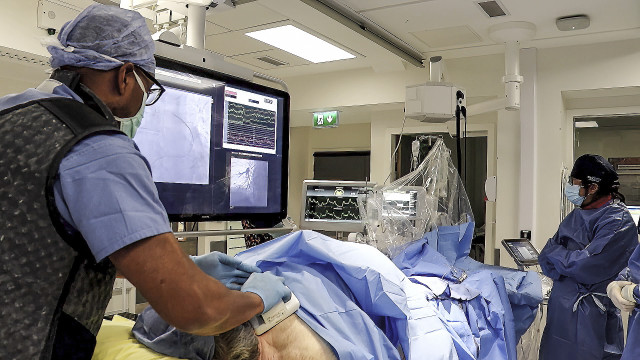You are here
University Hospital Galway trials new innovative technology for patients with heart failure

University Hospital Galway (UHG) has completed the final phase of an innovative clinical trial which reduces the hospitalisation rate for patients living with heart failure.
The trial which allows patients to be treated for heart failure from home has the potential to be a game changes in the treatment and monitoring of the condition.
Heart failure is a significant public health priority with patients requiring frequent hospitalisations. This new sensor allows cardiology teams to monitor patients remotely, avoiding hospitalisation. An internal audit in UHG of patients who received the sensor noted a 97% decrease in hospitalisation among this group.
The Cordella Pulmonary Artery Pressure Sensor detects changes in the health of patients with heart failure and securely transmits the information to the care team for review. If a change is detected, the team can then make changes to medications or other clinical interventions to prevent a heart failure flare-up requiring urgent hospitalisation.
“Over the last few years, UHG has conducted and completed three clinical trials with this unique device, in which 37 patients with advanced heart failure from the West and North West of the county have had the Cordella Sensor implanted. The trial was open for patients with heart failure, who met a certain criteria and who were being treated at the Heart Failure Clinic in UHG,” explains Prof Faisal Sharif, Consultant Interventional Cardiologist at UHG and Director of Cardiovascular Research and Innovation Centre, University of Galway, who is the clinical trial's principal investigator.
“We conducted an internal audit of all the patients in UHG who had the sensor placement, and were pleasantly surprised to see that hospitalisations for heart failure had decreased by 97%. This technology will improve patients' quality of life and keep them healthy in their own homes, and it has the potential to be a game changer in the treatment and monitoring of heart failure,” he added.
The sensor is placed in the right pulmonary artery of the heart to monitor pulmonary artery pressures within the heart muscle. Insertion of the sensor is a simple procedure that only requires an overnight stay in hospital.
The sensor is remotely connected to a computer system in the hospital and the heart pressures are transmitted via a cloud-based system where the clinical research nurses can review the pressures and advise accordingly. The Cordella System includes Bluetooth-enabled devices that measure blood pressure, weight, heart rate, and oxygen saturation, all of which are transmitted to the hospital.
“Patients with severe heart failure typically have elevated cardiac pressures before experiencing shortness of breath, so we have three to four days before the patient experiences dyspnea. By monitoring these pressures remotely, we can intervene and adjust their medication to reduce these pressures, prevent shortness of breath and avoid hospitalisation. One of the biggest problems with heart failure is that patients have very frequent hospitalisations.
“We see four to five times as many patients per year with heart failure symptoms and decompensation that require high dependency beds, intravenous medicines, and airway support, resulting in seven to ten days of hospitalisation. So by remotely and actively monitoring these patients, hospitalisation is avoided,” said Prof Sharif.
One of the most important aspects of this therapy is that the patient uses a portable device on their chest that transmits their cardiac pressure to the hospital. With the use of this technology, the patient becomes actively involved in their care.
“This is an example of patient engagement, patient empowerment, and the patient is, in reality, a member of the heart failure treatment team. Patient involvement leads to the monitoring of their weight, blood pressure, and oxygen saturations. And as a result, overall, leads to better quality of life. If you have a baseline of a patient's heart rate, oxygen saturation, body weight, blood pressure, and pulmonary artery pressure and compare it over time, you can see whether they are progressively worsening, improving, or maintaining volume status. And that's what keeps them well in the community,” said Prof Sharif.
Patient, Richard Power from Abbey, Loughrea, County Galway said, “Since the implant, I am very pleased with my life. Cordella wakes me at 8 o clock every morning to do my readings. It takes just five minutes and it saves me driving 50 kilometres, three or four times a month, and I am very grateful for Dr Sharif and his staff for what they have done for me.”
Ms Chris Kane, General Manager, Galway University Hospitals said, “The success of this clinical trial can be measured in the improvements in the patients’ quality of life, the dramatic reduction in the need for hospitalisation and the enhanced role that the patients are able to play in their own care. This is an excellent example of providing quality care in a patient’s own home environment to a level as close as possible to a hospital visit.”
The clinical trial is a collaboration between University Hospital Galway, University of Galway, Science Foundation Ireland and Endotronix, USA.
University Hospital Galway is one of two hospitals in Ireland to participate in the SIRONA II Cordella Pulmonary Artery Sensory System Clinical Trial for the management of heart failure patients utilising the Cordella system.
Photo
Cordella Pulmonary Artery Pressure Sensor Procedure
Prof Faisal Sharif and his team at University Hospital Galway testing the Cordella Pulmonary Artery Pressure Sensor in patient, Richard Power from Abbey, Loughrea, County Galway.
Video link – Prof Faisal Sharif, Consultant Interventional Cardiologist at UHG and Director of the Cardiovascular Research and Innovation Centre at the University of Galway talks about the new innovative technology and its potential to be a game changer in the treatment and monitoring of patients with advanced heart failure. https://www.youtube.com/watch?v=SGZcz24UylQ

